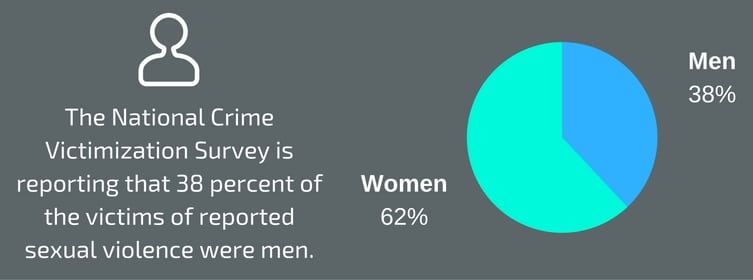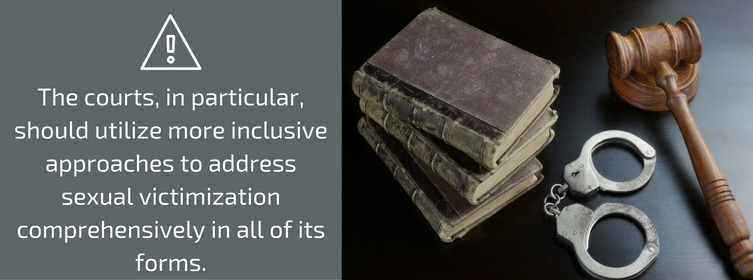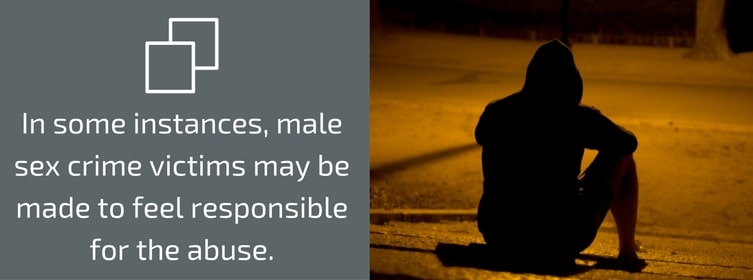When Lara Stemple, who is the Director of UCLA’s Health and Human Rights Law Project, was doing research on sex crimes two years ago, she discovered a statistic. The National Crime Victimization Survey is reporting that 38 percent of the victims of reported sexual violence were men. That’s a much higher figure than Stemple expected, so she continued.
Stemple – along with Williams Institute researchers Ilan Meyer and Andrew Flores – found that sex crimes committed by females are happening more frequently or at least are being reported more frequently. In Southern California, a Los Angeles sex crimes attorney would probably tell you the same thing – defense lawyers are defending more and more women charged with sex crimes.
Journalist Hannah Rosin has written, “Stemple is a longtime feminist who fully understands that men have historically used sexual violence to subjugate women and that in most countries they still do. As she sees it, feminism has fought long and hard to fight rape myths – that if a woman gets raped it’s somehow her fault, that she welcomed it in some way. But the same conversation needs to happen for men.”
HOW IS RAPE BEING REDEFINED?
The latest work by Stemple, Meyer, and Flores, published in the journal Aggression and Violent Behavior, says that old stereotypes – such as the idea that only men commit sexual violence – interfere with a comprehensive understanding of the nature of sex crimes. For example, the FBI for years defined rape as the “carnal knowledge of a female forcibly and against her will.” But a recent redefinition by the FBI now makes no mention of gender. “Sexual victimization perpetrated by men remains a serious, ongoing threat,” a new report states. “Without detracting from this, our research aims to reflect the broader reality that is women can also be perpetrators.”
The numbers are disturbing. The authors first present what they learned from the National Intimate Partner and Sexual Violence Survey, an ongoing, nationally representative survey conducted by the Centers for Disease Control and Prevention that measures both lifetime victimization and victimization within the twelve months prior to the survey. It found that over their lifetimes, women were vastly more likely to be victimized by sex crimes committed by men, but among men reporting victimization, 79.2 percent reported female assailants.
Next, the researchers considered a survey that focuses on violent crime, the National Crime Victimization Survey, conducted by the Bureau of Justice Statistics. After analyzing data from 2010 through 2013, the authors determined that female sex crime perpetrators acting without male co-perpetrators were reported in 28 percent of the rape or sexual assault incidents involving male victims and 4.1 percent of the incidents involving female victims. At least one female perpetrator was reported in 34.7 percent of the sex crime incidents with male victims and 4.2 percent of the sex crime incidents with female targets.
The researchers also considered a 2011 survey of 302 male college students. It found that 51.2 percent reported “at least one sexual victimization experience since age 16.” Nearly half of the male victims reported a female assailant. Researchers also looked at a 2014 study of 284 men and boys in colleges and high schools which found that 43 percent reported being sexually coerced. Of that 43 percent, 95 percent reported only female assailants.
ARE THE FIGURES SIMILAR FOR SEX CRIMES COMMITTED IN PRISONS?
To study sex crimes in state prisons, the authors considered data compiled by the Bureau of Justice Statistics. Citing the high level of “sexual victimization committed by female staff members and female inmates,” the authors determined that female prison inmates are “much more likely to be abused” by other women inmates than by male staff. One finding that may be surprising is that in state prisons, female state prisoners were more than three times as likely to experience sexual victimization perpetrated by women inmates (13.7 percent) than men were to be victimized by other male inmates (4.2 percent).
The researchers came to this conclusion: “These surveys have reached many tens of thousands of people, and each has shown internally consistent results over time. We therefore believe that this article provides more definitive estimates about the prevalence of female sexual perpetration than has been provided in the literature to date. Taken as a whole, the reports we examine document surprisingly significant prevalence of female-perpetrated sexual victimization, mostly against men and occasionally against women.”
The findings should trigger a reevaluation of long-held stereotypes about gender and victimization. The courts, in particular, should utilize more inclusive approaches to address sexual victimization comprehensively in all of its forms. This includes taking into account issues specific to LGBT people, young people and children, people of color, and people who are incarcerated or otherwise institutionalized.
ARE MALES MORE RELUCTANT TO REPORT SEX CRIMES?
In the past, investigators have learned that sex crime victims who experience sexual abuse in childhood from both women and men are more reluctant to disclose the victimization perpetrated by women. Male victims may also feel pressure to interpret sexual victimization by women in a way more aligned with masculine myths, such as a form of sexual initiation or a rite of passage, to make it seem less negative.
In some instances, male sex crime victims may be made to feel responsible for the abuse. Particularly as male victims move from childhood to adolescence, they are ascribed more blame for encounters with adult women. And when female abusers are reported by male sex crime victims, they are less likely to be investigated, prosecuted, or penalized compared to male sex crime perpetrators, who are generally thought to be more aggressive. That prejudice, however, is rapidly fading.
A reevaluation of stereotypes about gender and victimization need not come at the expense of women victimized by sex crimes, Stemple says, because “compassion is not a finite resource.” If you are accused of a sex crime in Southern California, whether you’re male or female, you’ll need the services of an experienced Los Angeles criminal defense attorney. If you are or become the victim of a sex crime, get to a place that’s safe, and call the police. Don’t hesitate to report a sex crime simply because you are male. Especially in larger cities like L.A., police departments are getting used to investigating sex crimes with male victims, so you will be taken seriously.














